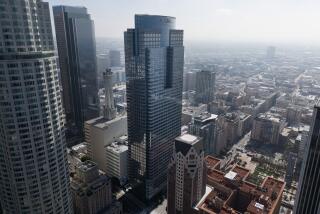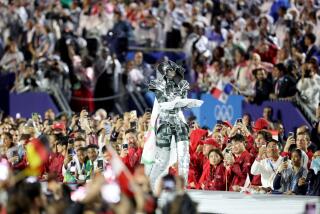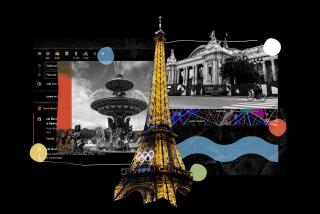Glory in Uselessness : The Eiffel Tower: Joke’s on Its Critics
- Share via
PARIS — Just over 100 years ago, the leading writers, artists and intellectuals of France banded together to denounce the impending construction of what they called “the useless and monstrous” Eiffel Tower. Their petition made them one of French history’s laughingstocks.
Ironically, their description, in a literal sense, was probably close to the mark. But writers such as Alexandre Dumas and Guy de Maupassant, architects such as Charles Garnier, composers such as Charles Gounod and all the tower’s other famous critics were guilty of a great failure of imagination. They could not envision how the very uselessness and size of the tower would become its glory.
Once the Tallest
Today, it is hard to glimpse the tower looming over the aging, huddled buildings of Paris without marveling at its sheer audacity and at the imagination it took to design what was then the tallest structure in the world, construct it of girders of iron and set it for no purpose upon an elegant and genteel city.
Gustave Eiffel, the engineer who constructed the tower, always seemed a little defensive, at least in public, about its uselessness. In reply to the attack of the intellectuals, Eiffel insisted in 1887 that his tower would serve science as a laboratory on high for experiments and observations in meteorology, astronomy and physics.
But the defense sounded lame then, as it does today, when the tower is used to broadcast television throughout the Paris area, a phenomenon often cited as evidence that Eiffel was decades ahead of his time.
‘Overwhelming Myth’
“These uses are doubtless incontestable,” Roland Barthes, the late French sociologist, once wrote. “But they seem quite ridiculous alongside the overwhelming myth of the tower.”
Barthes called the Eiffel Tower “an utterly useless monument” and counted that as an essence of its greatness.
The New Society for the Development of the Eiffel Tower, the part-private, part-city-owned company that runs the tower now, appears to agree. To celebrate the 100th anniversary of the opening of the tower in 1889, the society is planning a rather odd, yet somehow fitting, tribute. It intends to launch a 15-mile-wide ring of mirrors 500 miles into space to reflect sunlight and light up the sky with a kind of necklace of stars. The launching would cost $1.5 million, the mirrors would last three years before breaking up--and the project would have no practical purpose.
The space necklace, proposed by a team of six French architects and scientists, was selected as the best of 100 entries in a recent contest for a 100th anniversary project.
“We tried to think if Gustave Eiffel were here today,” Grazena Szczesniak, the company’s public relations officer, said, “ . . . what would he do that is as foolish as the Eiffel Tower.”
The Eiffel Tower has become the symbol of Paris much as Michelangelo’s David is the symbol of Florence; the Washington Monument the symbol of Washington; the Kremlin and Red Square the symbol of Moscow; or the Statue of Liberty, another colossal French construction in which Eiffel had a hand, the symbol of New York. It is impossible544501536Eiffel Tower. It is impossible to come to Paris and escape the Eiffel Tower.
Short story writer De Maupassant, one of the original critics of the structure, used to insist that he often lunched at a restaurant in the Eiffel Tower even though he did not like the food. “It’s the only place in Paris where I don’t have to see it,” he said.
In 1986, 4.5 million visitors spent 110 million francs ($18 million) in entrance fees to climb the stairs or take the sets of elevators to the top of the tower. But it is hard to believe that any of them, except perhaps for a few descendants of De Maupassant, did so to avoid seeing the tower.
The Eiffel Tower was a product of the exuberant optimism of the late 19th Century, of the feeling that science and the Industrial Revolution could create anything and do so in a monumental way. Jules Verne, the 19th-Century science fiction writer who could spin impossible dreams of submarines hurtling 20,000 leagues under the sea and of journeys to the center of the Earth, was the spiritual father of the mood that spawned the tower.
The optimism may have been forced. David P. Billington, a professor of architecture and engineering at Princeton University, has said that for the French, “the Eiffel Tower was a way of recovering their country’s self-image as a great industrial nation after the ignominious defeat by the Germans in the Franco-Prussian War.”
Gustave Eiffel was one of the best known engineers and constructors in France when he asked his staff to design a tower for the international fair that France was staging in 1889 on the 100th anniversary of the French Revolution.
Two assistants, Emile Nouguier and Maurice Koechlin, proposed a tower in the shape of a soaring support for a bridge. Eiffel, who had constructed some of the most important bridges in Europe and had built the iron skeleton that supported the Statue of Liberty, was lukewarm about this design at first. But he changed his mind, bought the rights to the idea from his assistants and began to build a structure of four pylons curving upward to join into an enormous tower of iron.
Did Eiffel then receive more credit for the tower than he deserves? Bernard Marrey, a biographer of the engineer, believes that he may have had little to do with the design of the tower but deserves full credit nevertheless for building it.
“It is difficult to know if Eiffel worked on the design because we do not have the records of the Eiffel company,” Marrey said recently. “In my opinion, and contrary to what most people think, the role of the entrepreneur is more important than that of the designer. It’s one thing to design a project but another to realize it.
Descendants Bitter
“The descendants of Koechlin, however, are a little bitter because they think the tower should be called the Koechlin Tower.”
Despite the carping of its critics, the project evoked a great deal of enthusiasm in Paris 100 years ago. Even as early as Feb. 14, 1887, when the intellectuals published their plea to halt construction, work on the foundations had gone so far that no one really believed that it could be stopped. The critics simply wanted to set their objections down in a footnote to history.
It took 21 months to complete the tower, which is made up of 18,000 pieces of iron held together by 2.5 million rivets. It weighed 7,000 tons and reached a height of 986 feet, surpassing the Washington Monument to become the tallest structure in the world at the time. It remained the tallest until the 77-story Chrysler Building was built in New York in 1930.
With great fanfare and military parades, the Eiffel Tower was opened to the public on May 15, 1889. The honored guests included the President of France, the King of Siam, the Bey of Djibouti, the Shah of Persia, the Lord Mayor of London, the former Queen of Madagascar, the son of the Khedive of Egypt and the famous clown Tom Tit. The first visitor to pay his fee and climb toward the top was a 20-year-old Spaniard remembered now only as Don Carlos.
Eiffel, a small, squarish man of 56 with unruly hair and a gray beard, had climbed to the top of the tower six weeks earlier and planted a 22-foot-by-14-foot French flag there. He waited until opening day, however, to make the first entry in the gilded memory book of the tower.
“Ten to 12, 15 May 1889,” he wrote. “Opening of the exposition and entry of the public. At last!”
Blood-Curdling Speculations
An intrepid writer for the Paris edition of the New York Herald Tribune braved the elevators up to the top a month later and reported that the jerkiness of the ride prompted “the funny men amongst the passengers to indulge in small, blood-curdling speculations as to whether we should all be smashed flat when we had fallen to the bottom in case of an accident; whether the insurance companies would not refuse to pay the insurance money on account of our having unnecessarily exposed our lives contrary to the stipulations of the contract, and so on.”
Eiffel suffered a great defeat in the decade that followed: his participation in the failed attempt by Ferdinand de Lesseps to dig a Panama canal. French investors had put millions of francs into the scheme on the strength of the reputations of De Lesseps and Eiffel and felt defrauded. Eiffel received a suspended prison sentence of two years. But the disgrace did not last long, and his fame as the constructor of the Eiffel Tower has persisted.
The Eiffel Tower was not supposed to stay up for very long. Even the protesting intellectuals had counted on no more than two decades.
“For 20 years,” they complained, “we shall see, lengthening like a spot of ink, the odious shadow of the odious column of bolted-together pieces of iron.”
But the odious column soon became so much a part of Paris that few politicians would dare to contemplate tearing it down.
Other Projects Helped
The protest by the intellectuals, in fact, has had a way of helping all kinds of other controversial architectural projects in Paris. Whenever anyone attacks a project, its defenders bring up the old petition against the Eiffel Tower. The critics are thus reminded544499809laughingstock of history.
This argument was brought up to defend construction of the Montparnasse Tower more than a decade ago and is being used now to defend Boston architect I. M. Pei’s glass pyramid planned for the courtyard of the Louvre Museum.
The Eiffel Tower is so much a part of Paris now that $35 million was spent in the last decade to refurbish it, to substitute modern elevators and to create a spectacular sight at night with a new lighting system that casts illumination from among the iron girders.
Over the years, Eiffel, who died in 1923 at the age of 91, seemed to fret over the celebrity of his tower.
“I should be jealous of the tower,” he wrote when he was 80. “It is much more celebrated than I. People seem to believe it is my only work. But I have done others, after all.”
More to Read
The biggest entertainment stories
Get our big stories about Hollywood, film, television, music, arts, culture and more right in your inbox as soon as they publish.
You may occasionally receive promotional content from the Los Angeles Times.










